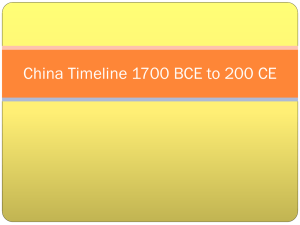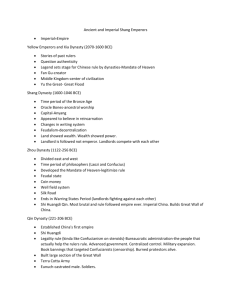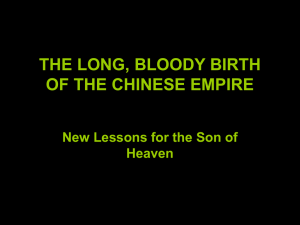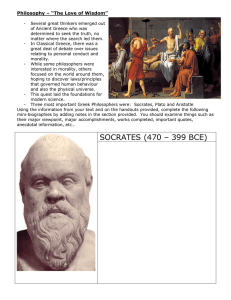Political Chapters 2,3,4 & 5
advertisement
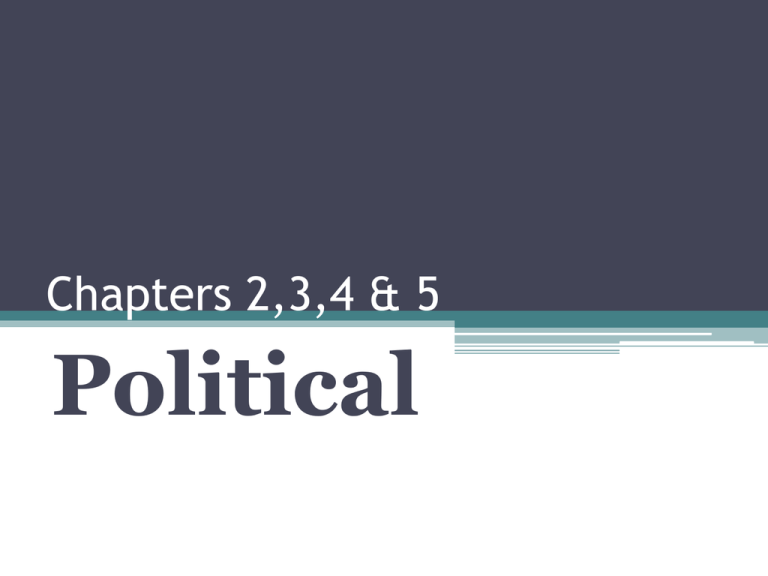
Chapters 2,3,4 & 5 Political You need to consider the following • How did the political patterns develop and fall in each area? • What similarities and differences develop? • What political styles turned out to be effective over other patterns? China: Dynasties • Development of a form of government known as the dynastic cycle • Very centralized 1 6 5 4 2 3 The Dynasty Song Shang, Chou, Qin, Han (SHONG, JOE, CHIN, HANN) Sui, Tang, Song (TSWAY, TONG, SOUNG) Yuan, Ming, Qin, Republic (u-JUAN, MING, CHING) Mao Ze Dong, Deng Xiaoping (MAO-TSE-DONG, DUNG-SHEEOU-PING) Zhou Dynasty (1029-258 BCE) • Ruled through alliances and noble families ▫ Unable to centrally control expanded borders so relied on a system of alliances to get troops and taxes ▫ This is basically feudalism and China’s feudal period How did the Zhou control the kingdom? ▫ Expanded territory to takeover the Yangtze River Valley ▫ Heightened central control through the concept of Mandate of Heaven (son of heaven) and by claiming ties with the Shang ▫ Promoted cultural unity by banning primitive religious practices ▫ Promoted a common language ▫ Confucius provided a set of common political beliefs ▫ Created a common legal code • Dynastic Cycle fall of Zhou and rise of Qin Qin Dynasty (221-202 BCE) • CENTRALIZATION ▫ Qin Shi Huangdi : First Emperor ▫ Took control of noble estates ▫ Organized China into large provinces ruled by bureaucrats appointed by the emperor ▫ Built a powerful army to dissuade regional rebellion ▫ Built the Great Wall to protect China from invaders • Legalism was the philosophical foundation of the empire Qin Innovation ▫ ▫ ▫ ▫ Increased central power Census to collect taxes Standard system of weights & measures Made Chinese written script uniform • Qin was too harsh and taxes too high. It fell and the Han rose Han Dynasty (202BCE – 220CE) • Saw the validity of Central Control without being brutal • Strong local rule continued to keep China in order while still maintaining loyalty to the rulers • Improved the state bureaucracy in order to create a more effective centralized government ▫ Set up an examination system for government employees. This was based on Confucian philosophy • Cultural unity in Confucianism with shrines built • Expanded borders again • Contact with India and Middle East Han contd. • Wu-Ti= Most Famous Han Ruler ▫ Establish Confucian thought as basis of government and society ▫ Create a school to train bureaucrats ▫ Improved Government functions • State not highly militaristic; more judicial in nature • Sponsored a lot of intellectual life • Gov. actively involved in the economy- regulating measurements, storing grain, etc. • All subjects were taxed and required to do annual labor in public projects • Disobedience was punished harshly Political theory throughout the Dynasties Regionalism Legalism Confucianism Rome Roman State • Began as a monarchy in southern Italy in 800 BCE • By 509 BCE, Roman aristocrats had driven out the monarchy and established more complex institutions Roman Republic • Approximately 500 BCE Republic established and begins to exert influence over rest of Italian peninsula • Strong military orientation • 3 Punic wars from 264-146 BCE greatly extend territory • Republic became unstable because generals wanted more political power • By 45 BCE Julius Caesar takes power and that marks the end of the traditional Roman state Governance in the Republic • City-state organization lent itself to developing ownership • Citizens often participated in the military giving them a greater stake in politics • Concept of active citizenship unique to Mediterranean culture • Indirect Democracy • Constitution tried to reconcile problem of aristocratic control so all citizens could participate • 2 Consuls who shared executive power • Senate (patricians) • Tribunes (plebeians) • Twelve Tables: created a standardized system of laws and established rights for defendants • When defeating others in battle: assimilated conquered people ▫ Meant that many forms of political institutions Roman Empire and Pax Romana (31476 CE) • Augustus: First Emperor • NOT a dynasty: succession often depended upon military strength • Kept the Senate but it was basically useless • A lot of regional autonomy still • Strong military organization • Network of roads for military transport and commerce • Proconsuls to govern regions • Sharply divided between citizens and non-citizens • Pubic entertainment to distract subjects and keep them happy • Roman law- Rules became more objective • Laws as a regulator of social life and held the empire together • Legalize Christianity in 300s CE to attempt cultural unity otherwise no attempt to force a common religion Let’s talk about Persia So Persia (550 – 331 BCE) • Founded by Cyrus the Great (550-530 BCE) who conquered other Iranian tribes • continued by Darius I • Largest empire yet Concept of divine authority often employed Zoroastrianism important to Darius’s rule Complex Government • 20 provinces headed by a satrap or governor (similar to proconsuls in Rome) • The satrap position was often hereditary • Taxes or tribute sent to the central government by the satrap • Single currency • Complex royal road system built • Postal system • Central administration set up in Elam and Mesopotamia using trained administrators and scribes India: different kind of dynasties • Very Regional • Subject to frequent invasions • From the beginning India was very individualistic. ▫ Religion • The trick with the two Indian dynasties was: ▫ How do you control and connect ALL these different peoples No song for this one • Mauryan Dynasty • Gupta Dynasty Mauryan Dynasty (324- 184 BCE) • From the end of the Epic Age until the 4th c. BCE Indian plains divided among powerful regional states ▫ 16 states by 600 BCE, some monarchies and others republics dominated by a priestly class and warriors • 322 BCE Alexander the Great invades • Chandragupta ▫ 1st rule to unify the subcontinent ▫ Very autocratic, relying on personal and military power • Developed an elaborate bureaucracy that ruled from Pataliputra (even had a postal system) • Maintained large armies • Network of spies to maintain control • Tax collection Ashoka • Ashoka ▫ Expanded Mauryan land ▫ Brutal until he converts to Buddhism and then promotes peace ▫ Pillars of Ashoka • After Ashoka the empire fell apart. ▫ It was too difficult to unite for long because they never integrated the population enough • Kushans push into India but collapsed by 220 CE Gupta Dynasty (320– 600 CE) • Out of the instability came a new empire • Larger and less centrally controlled ▫ Rulers preferred to intermarry and negotiate with local princes to expand influence • Claimed they had been appointed by the gods to rule and furthered Hinduism • Allowed for more regional control • • • • ▫ Due to the individual nature of the subcontinent, this created more stability ▫ No bureaucracy – they allowed regional control as long as the regional rulers deferred to them Uniformed code of laws Promoted Sanskrit Sponsored road building Ultimately, no political culture existed here like in China and Mediterranean partly because the caste system regulated many social relationships Greece: “Democracy” (500 – 338 BCE) • Greeks were Indo-Europeans who took over the peninsula by 1700 BCE • 800-600 BCE rapid rise of Greece based strong on city-states • Beginning of the thoughts of active participation in politics • Developed out of a polis system (Greece) ▫ Strong city-states ▫ BUT they are able to come together under a centralized government • Many of todays political theories started here Direct Democracy: • all can directly participate (if you are a citizen) ▫ This is Greece ▫ Why is this not reasonable Representative Democracy: • all choose elected officials to represent them in government ▫ Indirect Democracy ▫ This is Rome (REPUBLIC) Greece • Two strongest city-states were Athens and Sparta ▫ Also very different political theories Oligarchy/militarism Direct Democracy • Peloponnesian Wars (431-404 BCE) put Athens and Sparta against each other • Pericles ▫ Ruled during the Golden Age of Athens • Fell to the Macedonian Kings in the North Macedonia • Phillip II took over the Greek city states and his son Alexander establishes the Macedonian empire • While his reign was short lived, Alexander conquered a vast amount of territory and successor regional kingdoms continued to rule after his death • Hellenistic period ▫ Greeks were called Hellenes ▫ Greek art merged with other Middle Eastern forms creating a unique form ▫ Trade and science flourished, especially in cities like Alexandria in Egypt China (Not too bad) • End of the dynastic cycle ▫ God allowed invaders (Huns) to take over China so there wasn’t anyone with favor ▫ Someone had to restart the cycle Daoists: Yellow Turbans • Sui Tang • Not a complete downfall ▫ Basic core of the government was too strong to fall ▫ Threatened but not destroyed India (not great) • Again invaders were able to dismantle the Gupta empire • Central power over regional princes had been declining for awhile • Different: ▫ Invaders didn’t take over instead they were integrated into the warrior caste • Rajput: regional princes • Religion stayed strong Greece & Rome (DONE) • Slow decline into the abbess • Normal problems we have already seen • Death Spiral ▫ ▫ ▫ ▫ ▫ ▫ Population decline VERY bad emperors Plague Invaders Alliances New ideas What were politics like during the classical period? • • • • What is similar throughout? What could be considered a pattern? This is a time of growth, change and conquest We see the emergence of 3 major areas of strength and influence

